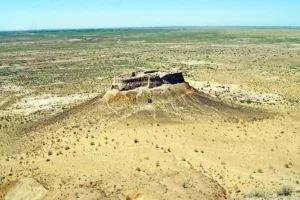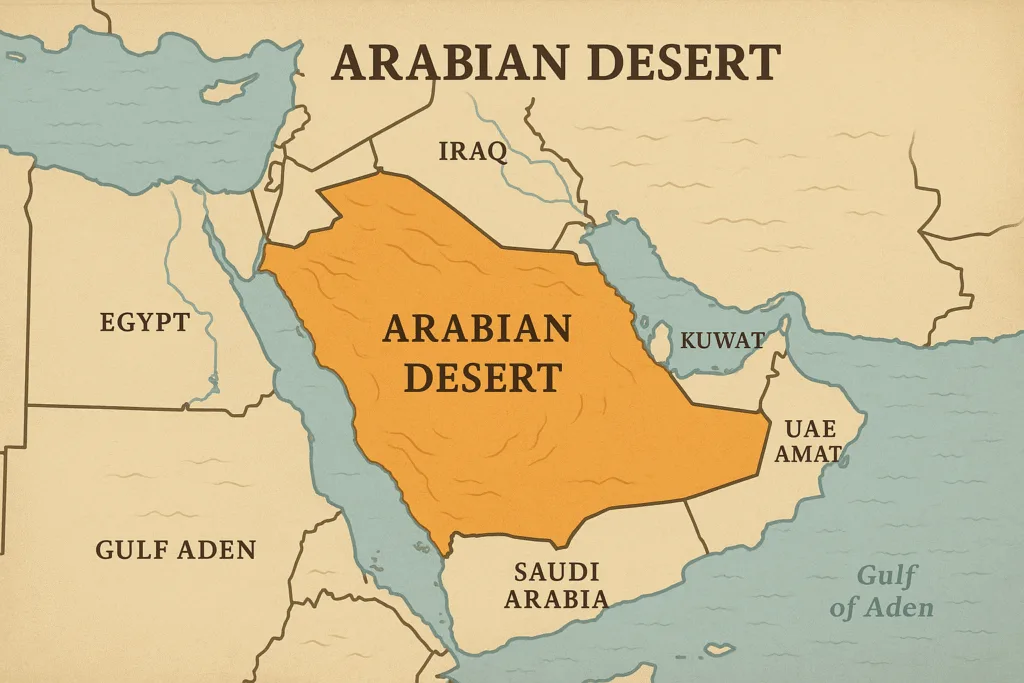Location & Continent
Continent: Asia
Countries: Uzbekistan, Kazakhstan, Turkmenistan
Coordinates: 41°N, 64°E
Kyzyl Kum – Map & Street View
Photos of the Kyzyl Kum Desert
Physical Features
Area: ~298,000 km² (one of the largest deserts in Central Asia)
Length: ~1,000 km (west–east)
Width: ~300–600 km (north–south)
Elevation: Mostly 100–300 m above sea level; higher in bordering uplands like the Nuratau foothills
Climate & Precipitation
Temperature: Peak summer heat often 45–50 °C; winters commonly −20 to −30 °C
Precipitation: ~80–200 mm per year on average, highly variable and mostly in late winter–spring; snowfall contributes a significant share
Ecological Features
Ecozone: Palearctic (cold desert and semi-arid steppe)
Biome: Temperate desert & xeric shrubland with pockets of riparian “tugai” woodland along major rivers
Ecoregions: Kyzylkum Desert (Turanian deserts), Northern Turan Desert, Amu Darya riparian tugai (edge habitats)
Flora & Fauna
Flora: Saxaul (Haloxylon) woodland patches, wormwood (Artemisia), saltworts (Salsola), Calligonum shrubs, tamarisk in dry valleys, and spring ephemerals following rare rains
Fauna: Goitered gazelle, saiga (seasonal movements), caracal, sand cat, corsac fox, desert monitor (Varanus griseus), Central Asian tortoise (Testudo horsfieldii), jerboas, houbara bustard, larks and wheatears
Geology & Notable Features
Geology: Vast aeolian sand seas with barchan and dome dunes, gravelly plateaus, takyr clay pans, and ancient river terraces between the Amu Darya and Syr Darya
Notable Features: Muruntau—one of the world’s largest open-pit gold mines; Aydar-Arnasay lake system on the northeast fringe; Sarmishsay Gorge petroglyphs; oases around Bukhara and Navoi; the Nuratau-Kyzylkum landscape corridor linking steppe, desert, and mountain habitats
Introduction
The Kyzyl Kum desert, translating to Red Sand, is one of the most fascinating deserts in Central Asia. Spanning across Uzbekistan and Kazakhstan, it is distinguished by its unique geological features, rich biodiversity, and historical significance. This article aims to provide an in-depth comparison of various aspects of the Kyzyl Kum desert, focusing on its geography, climate, flora and fauna, human activity, and conservation efforts.
Geography
The Kyzyl Kum desert covers an area of approximately 298,000 square kilometers, making it one of the largest deserts in Central Asia. It is bordered by the Amu Darya River to the south and the Ural River to the northeast. The geographical features include vast sand dunes, rocky outcrops, and occasionally, oases that create pockets of life in this arid environment. The topography is predominantly flat, with some areas experiencing undulating sand waves reaching heights of up to 100 meters.
Topographical Features
Within Kyzyl Kum, the landscape showcases a variety of formations. Below is a table illustrating some of these topographical features:
| Feature | Description | Location |
|---|---|---|
| Sand Dunes | Extensive fields of shifting sands that create picturesque landscapes. | Throughout the desert |
| Oases | Fertile spots where water sources support plant and animal life. | Near the old Silk Road route |
| Salt Flats | Areas of land covered with salt crusts that result from evaporation. | Western sections of Kyzyl Kum |
Climate
The climate of Kyzyl Kum is classified as a continental arid climate, characterized by hot summers and cold winters. Average summer temperatures can reach up to 40°C (104°F), while winter temperatures can plummet to as low as -20°C (-4°F). Rainfall is scarce, generally averaging around 80 mm annually, creating a harsh environment for most life forms.
Extreme Weather Conditions
The high temperature fluctuations and low precipitation levels contribute to the distinctive ecology of the desert. For instance, while the daytime can be blisteringly hot, nighttime temperatures can drop significantly, which poses challenges for wildlife and vegetation adapted to such conditions.
Flora and Fauna
Despite its harsh climate, the Kyzyl Kum desert is home to a surprising variety of plant and animal species. The flora mainly consists of sparse shrubs and saline-tolerant grasses, which have adapted to conserve water. Key plant species include:
- Wild Barley – A resilient grass that thrives in arid conditions.
- Halogeton – Known for its salt-tolerant properties.
- Desert Wormwood – A shrub that can survive with minimal water.
The fauna also includes unique species such as:
- Sand Gazelle – Adapted to traverse sandy terrains.
- Steppe Eagle – A top predator in the ecosystem.
- Desert Lizards – Various species that regulate their temperature through behavior.
Human Activity
The Kyzyl Kum desert has historically been significant for trade routes, particularly the ancient Silk Road, which facilitated cultural and economic exchanges between East and West. Today, human activities in the region include:
- Mining – Extraction of minerals, notably potash and other salts.
- Agriculture – Limited farming in oases, utilizing irrigation methods.
- Tourism – Eco-tourism initiatives aimed at exploring the desert’s unique ecology and landscapes.
Conservation Efforts
With growing environmental concerns, various conservation efforts are being implemented to protect the delicate ecosystem of Kyzyl Kum. These include:
- Protected Areas – Establishing reserves to preserve biodiversity.
- Sustainable Practices – Promoting eco-friendly tourism and responsible mining.
- Community Engagement – Involving local populations in conservation efforts to ensure sustainable land use.
Conclusion
In conclusion, the Kyzyl Kum desert is a unique and intricate ecosystem that plays a pivotal role in the natural and cultural landscape of Central Asia. Understanding its geography, climate, flora, fauna, human interaction, and conservation efforts is vital, not only for ecological balance but also for appreciating the rich history it holds. As we move forward, protecting this remarkable desert can ensure its survival for future generations.
References
Government / Official Sources
Government of Uzbekistan — “The State Reserve ‘Kyzylkum’”
U.S. Geological Survey — “Geology and structural evolution of the Muruntau gold deposit, Kyzylkum desert, Uzbekistan”
European Commission (JRC) — “Kyzylkum State Nature Reserve (Uzbekistan)”
University Sources
Monash University — “Microhabitat occupation and functional morphology of four species of sympatric agamid lizards in the Kyzylkum Desert”
University of East Anglia — “Habitat, abundance and productivity of the Asian Houbara in Kyzylkum”




